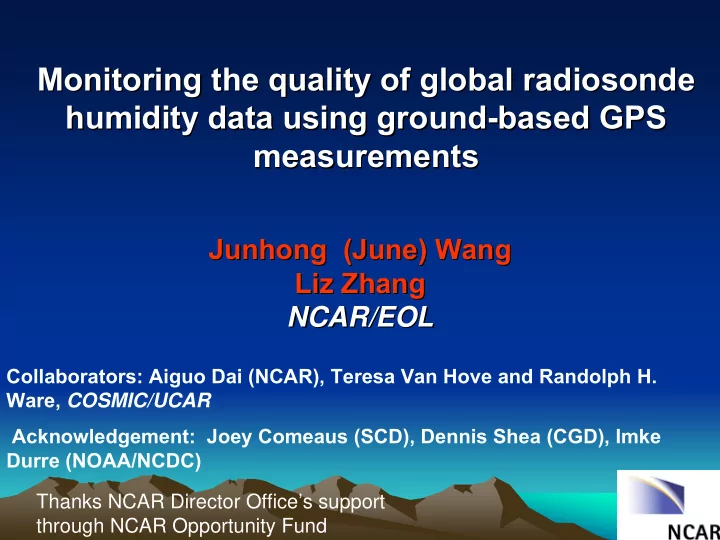

Monitoring the quality of global radiosonde Monitoring the quality of global radiosonde humidity data using ground- -based GPS based GPS humidity data using ground measurements measurements Junhong (June) Wang Junhong (June) Wang Liz Zhang Liz Zhang NCAR/EOL NCAR/EOL Collaborators: Aiguo Dai (NCAR), Teresa Van Hove and Randolph H. Ware, COSMIC/UCAR Acknowledgement: Joey Comeaus (SCD), Dennis Shea (CGD), Imke Durre (NOAA/NCDC) Thanks NCAR Director Office’s support through NCAR Opportunity Fund
GOALS 1)To develop an analysis technique for deriving a global, 2-hourly data set of atmospheric precipitable water (PW) using existing ground- based GPS measurements of zenith path delay (ZPD), 2)To use GPS PW data to monitor the quality of global radiosonde humidity data and estimate the diurnal sampling errors in twice-daily radiosonde humidity.
How does it work and Why using GPS data? How does it work and Why using GPS data? Total delay = Ionosphere + dry + wet • All weather • Continuous measurements • High temporal resolution • High accuracy (~1-2 mm) • Long term stability
DATA: Global ZPD data: ~359 stations, 1997 Global ZPD data: ~359 stations, 1997- -present, 2 present, 2- -hourly hourly DATA:
ANALYSIS TECHNIQUE AND VALIDATION Input: ZPD = ZHD + ZWD P s from GPS P s from global surface synoptic surface-met data observations with adjustment P = × s ZHD 2 . 2779 λ f ( , H ) ∑ P P N ∆ ∫ vi z v dz = i i 1 T T ≡ ≈ i ZWD = ZPD - ZHD T m P ∑ P ∫ N ∆ v vi dz z = i 2 2 i 1 T T i Tm from ERA-40 with horizontal and ∆ ∆ ∆Π PW T vertical interpolation = ≈ m Π PW T Output: m PW = ∏ * ZWD ∏ = f (Tm) Comparisons with radiosonde, MWR and others from field experiments for validations
“Global Estimates of Water-Vapor-Weighted Mean Temperature of the Atmosphere for GPS Applications” (Wang et al. 2005) 1. Radiosonde data: The Integrated Global Radiosonde Archive (IGRA) from NCDC, 1938 to present. 2. ERA-40: ~1.125°X1.125° (TL 159), 60 vertical levels, 6- hourly, 1957-2002. 3. NCEP/NCAR reanalysis (NNR): ~1.875°X1.875° (T62), 28 vertical levels, 6 hourly, 1948-present. 4. Bevis Tm-Ts relationship: Tm = 70.2 + 0.72*Ts
ERA40-IGRA Annual mean Tm difference between reanalysis and IGRA • 10% and 16% of stations NCEP/NCAR-IGRA with | ∆ Tm| < 2K for ERA-40 and NNR • ERA40 better than NNR • ERA40: a better option for global estimate of Tm
Annual mean Tm difference between Bevis and IGRA Warmer with maximum over Mountains ~1-6K colder with maximum marine stratus regions
Amplitude of Tm/Ts diurnal cycle Diurnal biases in Tm_Bevis Tm = 70.2 + 0.72*Ts Tm_Bevis 00 UTC 06 UTC Tm_ERA40 12 UTC 18 UTC Ts
Six-year (1997-2002) seasonal mean of PW (mm)
Monitoring of the “health” of global radiosonde humidity data 2001 (DeltaElevation < 100m; Distance < 50 km) RS80A 4 RS80H 3.5 RS90 3 Shang VIZ-type 2.5 MRZ VIZ-type 2 Meisei PW (mm RAOB-GPS) 1.5 1 0.5 0 6 1 0 9 9 1 9 0 8 9 8 7 0 7 9 9 0 0 9 7 0 7 7 7 7 9 6 1 0 1 9 5 5 5 5 5 3 2 2 4 4 9 7 9 8 -0.5 8 7 4 4 6 6 3 8 9 4 9 1 4 1 3 4 6 1 4 8 3 0 2 2 0 1 1 5 6 2 1 5 1 7 4 7 3 9 1 3 7 1 8 1 9 9 6 2 2 9 1 9 2 5 9 5 8 0 9 1 9 4 0 6 0 8 3 4 2 2 5 9 4 2 3 9 5 4 4 5 0 3 5 8 2 1 2 3 3 5 -1 0 0 0 9 9 4 8 2 7 7 6 0 1 1 1 9 4 0 1 1 8 5 0 0 6 9 9 2 6 7 3 9 6 9 1 3 4 7 2 9 2 1 9 6 3 6 7 2 4 6 4 6 1 1 5 4 1 8 3 2 2 8 0 0 4 8 1 3 4 1 6 5 2 4 8 7 4 0 6 2 0 3 2 1 5 2 2 7 6 2 -1.5 -2 RS80A -2.5 -3
Diurnal PW sampling errors in twice- -daily daily Diurnal PW sampling errors in twice radiosonde data (U.S.) radiosonde data (U.S.) Dai et al. (2002)
CONCLUSIONS AND FUTURE WORK 1) An analysis technique is developed to create a global, 2- hourly PW dataset. The technique needs to be validated and improved if necessary. 2) Preliminary analysis of PW differences between GPS and radiosonde data at 45 stations around the globe shows dry biases at most of Vaisala stations, but moist biases at all stations using carbon hygristor. This type of comparisons will be done to multi-year data, and more analyses are needed. 3) Errors in seasonal mean humidity due to under-sampling the diurnal cycle with twice-daily synoptic sounding are small (within ± 2%) over the globe. More careful and detailed analyses will be done to quantify the error and its spatial and temporal distributions. The sampling error of once-daily sounding will be also estimated.
Diurnal biases in Bevis Tm
Tm_Bevis Ts Amplitudes of Tm diurnal cycle Tm_RAOB
8. Monitoring of the quality of radiosonde humidity data for NWP Comparisons of PW from GPS and radiosonde on Oct. 21-25, 2003 in La Jolla (9 km apart, 134/69 m elevations) From NOAA/FSL (2004 Technical Review)
Six-year (1997-2002) seasonal mean of diurnal sampling errors
Diurnal sampling errors (%) of twice daily radiosonde data
Recommend
More recommend